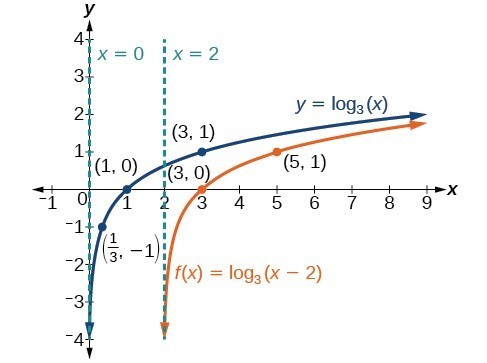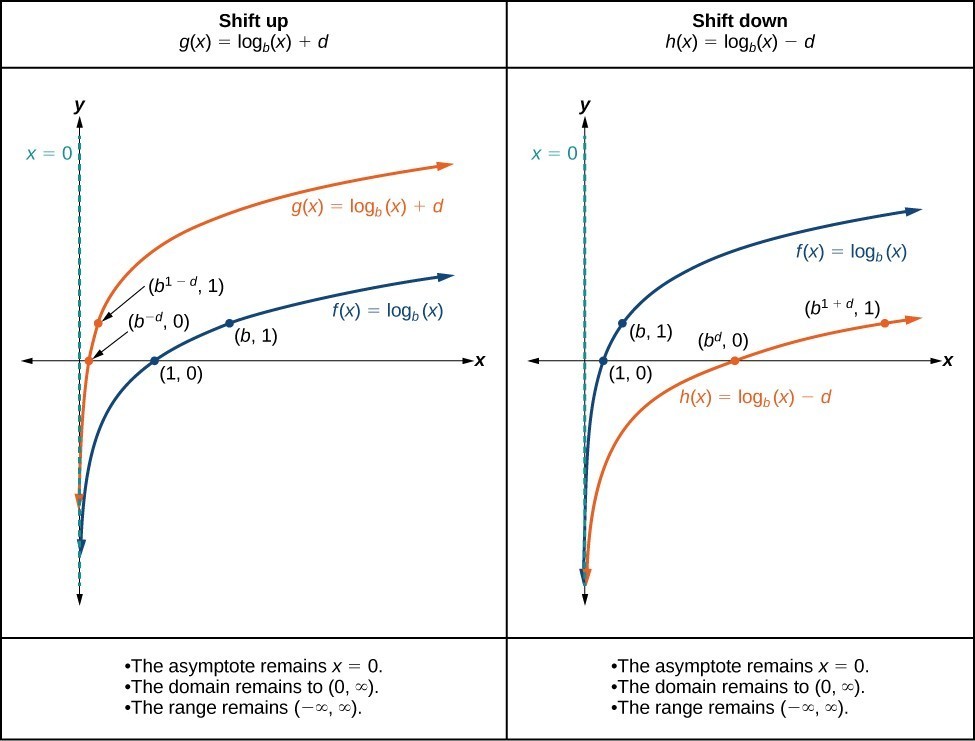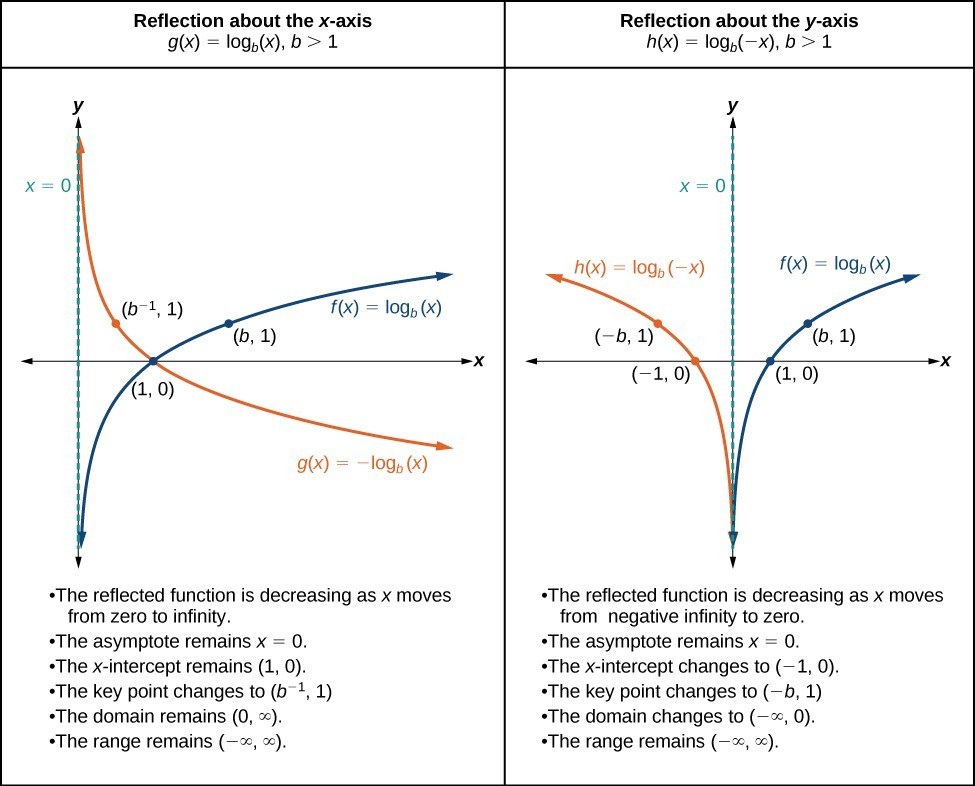
As we mentioned in the beginning of the section, transformations of logarithmic graphs behave similarly to those of other parent functions. We can shift, stretch, compress, and reflect the parent function [latex]y=<\mathrm
When a constant c is added to the input of the parent function [latex]f\left(x\right)=\text_\left(x\right)[/latex], the result is a horizontal shift c units in the opposite direction of the sign on c. To visualize horizontal shifts, we can observe the general graph of the parent function [latex]f\left(x\right)=<\mathrm>_\left(x\right)[/latex] and for c > 0 alongside the shift left, [latex]g\left(x\right)=<\mathrm>_\left(x+c\right)[/latex], and the shift right, [latex]h\left(x\right)=<\mathrm>_\left(x-c\right)[/latex].

For any constant c, the function [latex]f\left(x\right)=<\mathrm
Sketch the horizontal shift [latex]f\left(x\right)=<\mathrm
Since the function is [latex]f\left(x\right)=<\mathrm
The vertical asymptote is [latex]x=-\left(-2\right)[/latex] or x = 2.
Consider the three key points from the parent function, [latex]\left(\frac,-1\right)[/latex], [latex]\left(1,0\right)[/latex], and [latex]\left(3,1\right)[/latex].
The new coordinates are found by adding 2 to the x coordinates.
Label the points [latex]\left(\frac,-1\right)[/latex], [latex]\left(3,0\right)[/latex], and [latex]\left(5,1\right)[/latex].
The domain is [latex]\left(2,\infty \right)[/latex], the range is [latex]\left(-\infty ,\infty \right)[/latex], and the vertical asymptote is x = 2.

Sketch a graph of [latex]f\left(x\right)=<\mathrm
When a constant d is added to the parent function [latex]f\left(x\right)=<\mathrm

For any constant d, the function [latex]f\left(x\right)=<\mathrm
Sketch a graph of [latex]f\left(x\right)=<\mathrm
Since the function is [latex]f\left(x\right)=<\mathrm
This means we will shift the function [latex]f\left(x\right)=<\mathrm
The vertical asymptote is x = 0.
Consider the three key points from the parent function, [latex]\left(\frac,-1\right)[/latex], [latex]\left(1,0\right)[/latex], and [latex]\left(3,1\right)[/latex].
The new coordinates are found by subtracting 2 from the y coordinates.
Label the points [latex]\left(\frac,-3\right)[/latex], [latex]\left(1,-2\right)[/latex], and [latex]\left(3,-1\right)[/latex].

The domain is [latex]\left(0,\infty \right)[/latex], the range is [latex]\left(-\infty ,\infty \right)[/latex], and the vertical asymptote is x = 0.
Figure 9. The domain is [latex]\left(0,\infty \right)[/latex], the range is [latex]\left(-\infty ,\infty \right)[/latex], and the vertical asymptote is x = 0.
Sketch a graph of [latex]f\left(x\right)=<\mathrm
When the parent function [latex]f\left(x\right)=<\mathrm

For any constant a > 1, the function [latex]f\left(x\right)=a<\mathrm
Sketch a graph of [latex]f\left(x\right)=2<\mathrm
Since the function is [latex]f\left(x\right)=2<\mathrm
This means we will stretch the function [latex]f\left(x\right)=<\mathrm
The vertical asymptote is x = 0.
Consider the three key points from the parent function, [latex]\left(\frac,-1\right)[/latex], [latex]\left(1,0\right)[/latex], and [latex]\left(4,1\right)[/latex].
The new coordinates are found by multiplying the y coordinates by 2.
Label the points [latex]\left(\frac,-2\right)[/latex], [latex]\left(1,0\right)[/latex], and [latex]\left(4,\text\right)[/latex].

The domain is [latex]\left(0,\infty \right)[/latex], the range is [latex]\left(-\infty ,\infty \right)[/latex], and the vertical asymptote is x = 0.
Figure 11. The domain is [latex]\left(0,\infty \right)[/latex], the range is [latex]\left(-\infty ,\infty \right)[/latex], and the vertical asymptote is x = 0.
Sketch a graph of [latex]f\left(x\right)=\frac<\mathrm
Sketch a graph of [latex]f\left(x\right)=5\mathrm\left(x+2\right)[/latex]. State the domain, range, and asymptote.

Remember: what happens inside parentheses happens first. First, we move the graph left 2 units, then stretch the function vertically by a factor of 5. The vertical asymptote will be shifted to x = –2. The x-intercept will be [latex]\left(-1,0\right)[/latex]. The domain will be [latex]\left(-2,\infty \right)[/latex]. Two points will help give the shape of the graph: [latex]\left(-1,0\right)[/latex] and [latex]\left(8,5\right)[/latex]. We chose x = 8 as the x-coordinate of one point to graph because when x = 8, x + 2 = 10, the base of the common logarithm.
Figure 12. The domain is [latex]\left(-2,\infty \right)[/latex], the range is [latex]\left(-\infty ,\infty \right)[/latex], and the vertical asymptote is x = –2.
Sketch a graph of the function [latex]f\left(x\right)=3\mathrm\left(x - 2\right)+1[/latex]. State the domain, range, and asymptote.
When the parent function [latex]f\left(x\right)=<\mathrm

The function [latex]f\left(x\right)=<\mathrm<-log>>_\left(x\right)[/latex]
The function [latex]f\left(x\right)=<\mathrm
| [latex]\textf\left(x\right)=-<\mathrm | [latex]\textf\left(x\right)=<\mathrm |
|---|---|
| 1. Draw the vertical asymptote, x = 0. | 1. Draw the vertical asymptote, x = 0. |
| 2. Plot the x-intercept, [latex]\left(1,0\right)[/latex]. | 2. Plot the x-intercept, [latex]\left(1,0\right)[/latex]. |
| 3. Reflect the graph of the parent function [latex]f\left(x\right)=<\mathrm | 3. Reflect the graph of the parent function [latex]f\left(x\right)=<\mathrm |
| 4. Draw a smooth curve through the points. | 4. Draw a smooth curve through the points. |
| 5. State the domain, [latex]\left(0,\infty \right)[/latex], the range, [latex]\left(-\infty ,\infty \right)[/latex], and the vertical asymptote x = 0. | 5. State the domain, [latex]\left(-\infty ,0\right)[/latex], the range, [latex]\left(-\infty ,\infty \right)[/latex], and the vertical asymptote x = 0. |
Sketch a graph of [latex]f\left(x\right)=\mathrm\left(-x\right)[/latex] alongside its parent function. Include the key points and asymptote on the graph. State the domain, range, and asymptote.
Before graphing [latex]f\left(x\right)=\mathrm\left(-x\right)[/latex], identify the behavior and key points for the graph.

Figure 14. The domain is [latex]\left(-\infty ,0\right)[/latex], the range is [latex]\left(-\infty ,\infty \right)[/latex], and the vertical asymptote is x = 0.
Graph [latex]f\left(x\right)=-\mathrm\left(-x\right)[/latex]. State the domain, range, and asymptote.
Solve [latex]4\mathrm\left(x\right)+1=-2\mathrm\left(x - 1\right)[/latex] graphically. Round to the nearest thousandth.
Press [Y=] and enter [latex]4\mathrm\left(x\right)+1[/latex] next to Y1=. Then enter [latex]-2\mathrm\left(x - 1\right)[/latex] next to Y2=. For a window, use the values 0 to 5 for x and –10 to 10 for y. Press [GRAPH]. The graphs should intersect somewhere a little to right of x = 1.
For a better approximation, press [2ND] then [CALC]. Select [5: intersect] and press [ENTER] three times. The x-coordinate of the point of intersection is displayed as 1.3385297. (Your answer may be different if you use a different window or use a different value for Guess?) So, to the nearest thousandth, [latex]x\approx 1.339[/latex].
Solve [latex]5\mathrm\left(x+2\right)=4-\mathrm\left(x\right)[/latex] graphically. Round to the nearest thousandth.
Now that we have worked with each type of translation for the logarithmic function, we can summarize each in the table below to arrive at the general equation for translating exponential functions.
All translations of the parent logarithmic function, [latex]y=<\mathrm
where the parent function, [latex]y=<\mathrm
For [latex]f\left(x\right)=\mathrm\left(-x\right)[/latex], the graph of the parent function is reflected about the y-axis.
What is the vertical asymptote of [latex]f\left(x\right)=-2<\mathrm
The vertical asymptote is at x = –4.
The coefficient, the base, and the upward translation do not affect the asymptote. The shift of the curve 4 units to the left shifts the vertical asymptote to x = –4.
What is the vertical asymptote of [latex]f\left(x\right)=3+\mathrm\left(x - 1\right)[/latex]?
Find a possible equation for the common logarithmic function graphed in Figure 15.
 been vertically reflected, and passes through the points (-1, 1) and (2, -1)." width="487" height="367" />
been vertically reflected, and passes through the points (-1, 1) and (2, -1)." width="487" height="367" />
This graph has a vertical asymptote at x = –2 and has been vertically reflected. We do not know yet the vertical shift or the vertical stretch. We know so far that the equation will have form:
[latex]f\left(x\right)=-a\mathrmIt appears the graph passes through the points [latex]\left(-1,1\right)[/latex] and [latex]\left(2,-1\right)[/latex]. Substituting [latex]\left(-1,1\right)[/latex],
[latex]\begin
Next, substituting in [latex]\left(2,-1\right)[/latex],
[latex]\begin
This gives us the equation [latex]f\left(x\right)=-\frac<\mathrm\left(4\right)>\mathrm\left(x+2\right)+1[/latex].
We can verify this answer by comparing the function values in the table below with the points on the graph in Example 11.
| x | −1 | 0 | 1 | 2 | 3 |
| f(x) | 1 | 0 | −0.58496 | −1 | −1.3219 |
| x | 4 | 5 | 6 | 7 | 8 |
| f(x) | −1.5850 | −1.8074 | −2 | −2.1699 | −2.3219 |
Give the equation of the natural logarithm graphed in Figure 16.

Is it possible to tell the domain and range and describe the end behavior of a function just by looking at the graph?
Yes, if we know the function is a general logarithmic function. For example, look at the graph in Try It 11. The graph approaches x = –3 (or thereabouts) more and more closely, so x = –3 is, or is very close to, the vertical asymptote. It approaches from the right, so the domain is all points to the right, [latex]\left\